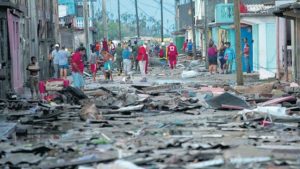
Red Cross workers and residents walk among the damage caused by Hurricane Matthew in Baracoa, Cuba, yesterday. The hurricane rolled across the sparsely populated tip of Cuba overnight, destroying dozens of homes in Cuba’s easternmost city, Baracoa, and leaving hundreds of others damaged.
PORT-AU-PRINCE, Haiti (AP) — Rescue workers in Haiti struggled to reach cut-off towns and learn the full extent of the death and destruction caused by Hurricane Matthew yesterday as the storm began battering The Bahamas and triggered large-scale evacuations along the United States East Coast.
At least 11 deaths were blamed on the powerful storm during its week-long march across the Caribbean, five of them in Haiti. But with a key bridge washed out, roads impassable and phone communications down, the western tip of Haiti was isolated and there was no full accounting of the dead and injured in Matthew’s wake.
After moving past Haiti, Matthew rolled across a corner of Cuba and then began pounding the southern Bahamas with winds of 120 mph (195 kph) and heavy rains on a course expected to take it near the capital city of Nassau.
Forecasters said the storm could hit Florida — or come dangerously close — late Thursday or early Friday, and then scrape the East Coast all the way up to the Carolinas over the weekend. Matthew could become the first major hurricane to blow ashore in the US since Wilma slashed across Florida in 2005.
Hundreds of thousands of people along the lower East Coast were urged to evacuate their homes.
“If you’re able to go early, leave now,” Florida Governor Rick Scott warned.
On Tuesday, Matthew swept across a remote area of Haiti with 145 mph (230 kph) winds, wrecking homes and swamping roads. But Government leaders in the poorest country in the western hemisphere said they weren’t close to fully gauging the effect in the flood-prone nation where less powerful storms have killed thousands.
“What we know is that many, many houses have been damaged. Some lost rooftops and they’ll have to be replaced, while others were totally destroyed,” Interior Minister Francois Anick Joseph said.
Mourad Wahba, the UN secretary-general’s deputy special representative for Haiti, said at least 10,000 people were in shelters and hospitals were overflowing. He called the hurricane the biggest humanitarian crisis in Haiti since the devastating earthquake of 2010.
The Haitian Government postponed Sunday’s presidential election, in part because many of the schools and churches that are used as polling stations are serving as shelters. A new date for the vote was not announced.
Aid groups with representatives in the area said it was clear that many homes and crops were destroyed, but that the extent was impossible to gauge, especially in the Grand Anse area on the southern tip, which took a direct hit.
“We have people in Grand Anse that we cannot reach,” Hervil Cherubin, country director for Heifer International, a nonprofit that works with local farmers.
While the capital, Port-au-Prince, was essentially back to normal, there was still widespread flooding across southern Haiti.
“There’s absolutely nothing we can do to protect ourselves here,” said motorcycle taxi driver Joseph Paul as he watched torrents of brown water wash over a road and deluge his low-lying neighborhood in Leogane. “This storm was too much for us, and we are at its mercy.”
The US government said it sent experts to Haiti to assess the damage and is providing $1.5 million in food and other disaster assistance.
The hurricane also blew across the sparsely populated tip of Cuba overnight, destroying dozens of homes in Cuba’s easternmost city, Baracoa, and damaging hundreds of others.
People stood amid the rubble of their homes, weeping, hugging or staring stunned into the distance. Others scoured piles of concrete and rebar for any possessions they could recover. Some carried cooking pots and rolled-up mattresses through the streets on their way to a shelter.
“I’ve never seen something like this in my life,” said Elva Perez, a 55-year-old homemaker, as she stood by what remained of her home. “For more than 200 years, here in this house, nothing like this has ever happened.”
At the US naval base at Guantanamo Bay, Cuba, the storm knocked down trees and caused road flooding but no injuries or major damage, said Julie Ripley, a spokeswoman.
At 2:00 pm yesterday, Matthew was centred about 70 miles (115 kilometers) south of Long Island in the eastern Bahamas. It was heading northwest at 12 mph (19 kph).
Along the East Coast, people boarded up beach homes, some schools closed and residents began clearing out.
South Carolina Gov Nikki Haley announced plans to evacuate a quarter-million people from the coast, not counting tourists, starting yesterday afternoon. Florida’s Broward County, which includes Fort Lauderdale, asked some 150,000 residents in low-lying areas or mobile homes to move to safety.
